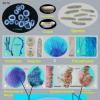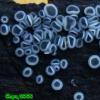
02-01-2026 17:43
MARICEL PATINOHi there, although I couldn't see the fruitbody, I

01-01-2026 18:35
Original loamy soil aside a artificial lake.The co

31-12-2025 19:27
Collected from loamy soil, at waterside (completel

30-12-2025 16:44
Pascal DucosBonjour,Une anamorphe rose stipitée, très nombre

30-12-2025 17:14
 Bernard CLESSE
Bernard CLESSE
Bonjour à toutes et tous,Pourriez-vous aider Albe
50200 - Mollisia lividofusca ?
Roland Labbé,
18-04-2010 01:03
Voici un Mollisia.
Nous croyons que c'est M. lividofusca.
Tout concorde microscopiquement, mais la coloration est-elle correcte pour cette espèce ?
Merci, Roland
Détails :
Date de récolte : 05 / 07 / 2009
Habitat : forêt de feuillus
Substrat : bois mort de feuillu peu décomposé
Sporée non disponible
Spores cylindriques, lisses, guttulées, avec parfois une petite guttule à chaque extrémité, 7-10 x 1,5-2 µm, 8,7 x 1,7 µm en moyenne(10 spores), Q = 5,1
Asques à 8 spores bisériées, avec crochet à la base et appareil apical amyloïde, 45-60 x 5-7 µm
Paraphyses cylindriques, parfois légèrement élargies à l’apex, ramifiées, septées, à contenu huileux à 80-90%, 50-60 x 1,5-2 µm
Poils marginaux cylindriques ou clavés
Poils de l’excipulum cylindriques, clavés ou rarement étroitement ventrus
Excipulum en textura globulosa et angularis
Subiculum formé d’hyphes septées, à paroi épaisse, brunes
Roland Labbé,
18-04-2010 01:05
Andreas Gminder,
18-04-2010 09:15

Re:50200 - Mollisia lividofusca ?
Bonjour,
je dirai que c'est presque certainement pas M. lividofusca. La macroscopie juste pas du tout et les caractères des spores ne justent non plus. M. lividofusca a des spores completement egguté et ils sont un peu plus grand. La caractère le plus signifiant pour M. lividofusca est le subhymenium coloré brun, même si on doit admettre que il y a ca et là des colections ou il y a quelques apothecias qui ne montrent pas cet caractère.
Comme vous avez vu le contenu huileux des paraphyses, vous doivent examiné la collection en etat vivant. Dans ce cas les spores sont trop petit pour M. lividofusca, mais aussi remarquablement mince - trop mince pour M. cinerea si le mesurements sont exact et les spores en etat vivant.
Il me semble néanmois que votre trouvaille est M. cinerea quelque chose voisin de cet espèce.
amicalement,
Andreas
je dirai que c'est presque certainement pas M. lividofusca. La macroscopie juste pas du tout et les caractères des spores ne justent non plus. M. lividofusca a des spores completement egguté et ils sont un peu plus grand. La caractère le plus signifiant pour M. lividofusca est le subhymenium coloré brun, même si on doit admettre que il y a ca et là des colections ou il y a quelques apothecias qui ne montrent pas cet caractère.
Comme vous avez vu le contenu huileux des paraphyses, vous doivent examiné la collection en etat vivant. Dans ce cas les spores sont trop petit pour M. lividofusca, mais aussi remarquablement mince - trop mince pour M. cinerea si le mesurements sont exact et les spores en etat vivant.
Il me semble néanmois que votre trouvaille est M. cinerea quelque chose voisin de cet espèce.
amicalement,
Andreas
Roland Labbé,
20-04-2010 01:30
Andreas Gminder,
20-04-2010 08:12

Re:50200 - Mollisia lividofusca ?
Cher Roland,
je croix que c'est cet espèce que j'ai dans ma clé provisoire sous le nom prov. "M. pyrenopezizoides". C'erst une espèce commun, et pour ca j'hesite de la decrire comme nouveaux, car je croix qu'il doit être deja decrit - mais sous quel nom ....?
Cet espèce est figuré dans "Champignon de Suisse" de BREITENBACH & KRÄNZLIN sous le nom de Mollisia ligni.
amicalement,
Andreas
je croix que c'est cet espèce que j'ai dans ma clé provisoire sous le nom prov. "M. pyrenopezizoides". C'erst une espèce commun, et pour ca j'hesite de la decrire comme nouveaux, car je croix qu'il doit être deja decrit - mais sous quel nom ....?
Cet espèce est figuré dans "Champignon de Suisse" de BREITENBACH & KRÄNZLIN sous le nom de Mollisia ligni.
amicalement,
Andreas
Roland Labbé,
20-04-2010 14:38
Re:50200 - Mollisia lividofusca ?
Thank you Andreas !
Friendly, Roland
Friendly, Roland
Roland Labbé,
20-04-2010 19:16
Re:50200 - Mollisia lividofusca ?
Do you know the species Haglundia elegantior ?
What's about it Andreas ?
Roland
What's about it Andreas ?
Roland
Andreas Gminder,
20-04-2010 22:58

Re:50200 - Mollisia lividofusca ?
Hello Roland,
M. elegantior is a completely different spcies in every respect.
It has no yellow reaction on KOH, spores 8-14 x 2,5-3 µm and with lot of oil drops inside, hairs up to 100 µm long and it grows on the underside of dead truncs of oak in winter and early spring. The most prominent character is the red reaction of the ascus pore in Lugol (blue in lower concentration).
M. olivascens (Haglundia perelegans) is similar to your collection what concerns KOH reaction and spore size, but also has long hairs up to 100 µm. It also grows on oak wood and has apothecia up to 7 mm.
best regards,
Andreas
M. elegantior is a completely different spcies in every respect.
It has no yellow reaction on KOH, spores 8-14 x 2,5-3 µm and with lot of oil drops inside, hairs up to 100 µm long and it grows on the underside of dead truncs of oak in winter and early spring. The most prominent character is the red reaction of the ascus pore in Lugol (blue in lower concentration).
M. olivascens (Haglundia perelegans) is similar to your collection what concerns KOH reaction and spore size, but also has long hairs up to 100 µm. It also grows on oak wood and has apothecia up to 7 mm.
best regards,
Andreas
Roland Labbé,
21-04-2010 00:18
Re:50200 - Mollisia lividofusca ?
Thank's Andreas,
The microscopy of our species is one of Mollisia.
I have often made your Molisia key and I get always on "M. pyrenopezizoides".
Best regard too !
Roland
The microscopy of our species is one of Mollisia.
I have often made your Molisia key and I get always on "M. pyrenopezizoides".
Best regard too !
Roland
Roland Labbé,
21-04-2010 05:16
Re:50200 - Mollisia lividofusca ?
On more question Andreas :
Why the name is not M. ligni intead of "M. pyrenopezizoides" ?
Roland
Why the name is not M. ligni intead of "M. pyrenopezizoides" ?
Roland
Andreas Gminder,
21-04-2010 08:10

Re:50200 - Mollisia lividofusca ?
Hello Roland,
Mollisia ligni is a different species, often misinterpreted. It is one of the very few Mollisia species on wood which has no ascus pore reaction on Lugols. Macroscopically it is quite pubescent and has microscopically multicellular marginal cells which protrude appr. 30-40 µm. It is a xerotolerant species which grows on hardwood still attached to the tree or shrub. When it dries slowly, the apothecia become oftent ypical triangular.
Though macroscopy in Mollisia is not very useful, there are some hints to species or to exclude species nevertheless. In M. ligni e.g. I have never observed a bluish-grey hymenium nor a white margin. M. ligni is always a somewhat dark species - very beautiful (as all Mollisia *ggg*)
So the species depicted and described in "Fungi of Switzerland" is just a misidentification, as it happens not too rarely in this genus. I revised the herbarium material and found it to be M. "pyrenopezizoides".
best regards,
Andreas
Mollisia ligni is a different species, often misinterpreted. It is one of the very few Mollisia species on wood which has no ascus pore reaction on Lugols. Macroscopically it is quite pubescent and has microscopically multicellular marginal cells which protrude appr. 30-40 µm. It is a xerotolerant species which grows on hardwood still attached to the tree or shrub. When it dries slowly, the apothecia become oftent ypical triangular.
Though macroscopy in Mollisia is not very useful, there are some hints to species or to exclude species nevertheless. In M. ligni e.g. I have never observed a bluish-grey hymenium nor a white margin. M. ligni is always a somewhat dark species - very beautiful (as all Mollisia *ggg*)
So the species depicted and described in "Fungi of Switzerland" is just a misidentification, as it happens not too rarely in this genus. I revised the herbarium material and found it to be M. "pyrenopezizoides".
best regards,
Andreas
Roland Labbé,
21-04-2010 18:36
Re:50200 - Mollisia lividofusca ?
Thank's a lot Andreas !
I think it's all OK.
Roland
I think it's all OK.
Roland






